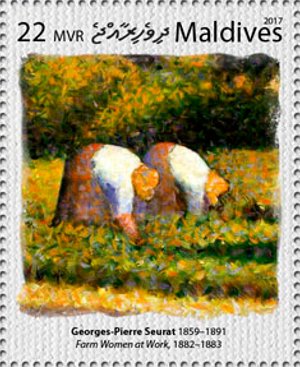Stamp: "Farm Women at Work" (1882-83) (Maldives 2017)
"Farm Women at Work" (1882-83) (Maldives 2017)
17 May (Maldives ) within release Georges-Pierre Seurat (1859–1891) goes into circulation Stamp "Farm Women at Work" (1882-83) face value 22 Maldivian rufiyaa
| Stamp "Farm Women at Work" (1882-83) in catalogues | |
|---|---|
| Michel: | Mi: MV 6998 |
Stamp is square format.
Although this issue was authorized by postal officials in the Maldives, the entire issue was distributed by the stamp agents representing the Maldives to the new issued trade, and not sold in the Maldives.Also in the issue Georges-Pierre Seurat (1859–1891):
- Stamp - "Le Bec du Hoc, Grandcamp" (1885) face value 22;
- Stamp - "The Circus" (1890-91) face value 70;
- Mini Sheet - Georges-Pierre Seurat (1859–1891) face value 4*22;
- Souvenir Sheet - Georges-Pierre Seurat (1859–1891) face value 70;
- Stamp - "The Channel of Gravelines, Petit Fort Philippe" (1890) face value 22;
- Stamp - "Farm Women at Work" (1882-83) face value 22;
- Stamp - "Gray Weather, Grande Jatte" (1886-88) face value 22;
Stamp "Farm Women at Work" (1882-83) it reflects the thematic directions:
Painting is a visual art, which is characterized by the practice of applying paint, pigment, color or other medium to a solid surface The medium is commonly applied to the base with a brush, but other implements, such as knives, sponges, and airbrushes, may be used. One who produces paintings is called a painter.
Painting is the practice of applying paint, pigment, color or other medium to a solid surface (support base). The medium is commonly applied to the base with a brush, but other implements, such as knives, sponges, and airbrushes, can be used. Painting is a mode of creative expression, and the forms are numerous. Drawing, gesture (as in gestural painting), composition, narration (as in narrative art), or abstraction (as in abstract art), among other aesthetic modes, may serve to manifest the expressive and conceptual intention of the practitioner. Paintings can be naturalistic and representational (as in a still life or landscape painting), photographic, abstract, narrative, symbolistic (as in Symbolist art), emotive (as in Expressionism), or political in nature (as in Artivism). A portion of the history of painting in both Eastern and Western art is dominated by spiritual motifs and ideas. Examples of this kind of painting range from artwork depicting mythological figures on pottery, to Biblical scenes rendered on the interior walls and ceiling of the Sistine Chapel, to scenes from the life of Buddha or other images of Eastern religious origin. In art, the term painting describes both the act and the result of the action. The support for paintings includes such surfaces as walls, paper, canvas, wood, glass, lacquer, clay, leaf, copper and concrete, and the painting may incorporate multiple other materials including sand, clay, paper, plaster, gold leaf, as well as objects. The term painting is also used outside of art as a common trade among craftsmen and builders.


